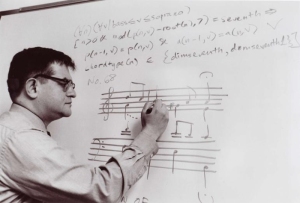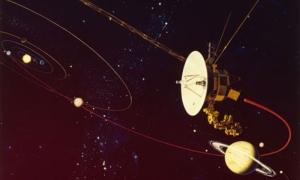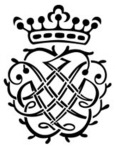Tags
Bhakti, Buxtehude, cantata, Carnatic music, chorale, Hildegard von Bingen, Johann Adam Reincken, Kannada, Karaikkal Ammaiyar, Latin, Martin Luther, Mein Freund ist mein, Meister Eckhart, Nietzsche, Purandaradasa, raga, Reformation, Sanskrit, Satyajith Andradi, tala, Tamil, Telugu, Tyagaraja, Wachet auf ruft uns die Stimme

Tyagaraja
The great composers Johann Sebastian Bach and Tyagaraja hailed from two worlds different from one another in space, time, race, language, religion, social order and musical tradition. Bach lived in Germany, while lived in South India, in present-day Tamilnadu. Bach died in 1750 whereas Tyagaraja was born seventeen years later in 1767. The former’s mother tongue was German whereas that of the latter was Telugu. Bach was a Christian whereas Tyagaraja was a Hindu. The former lived in a increasingly capitalistic semi-feudal society while the latter lived in a traditional caste-based society coming under the growing influence of British colonialism. The western musical tradition to which Bach belonged was polyphonic whereas the South Indian tradition to which Tyagaraja belonged was based on ragas and talas. Nonetheless, the most moving music of Bach is similar in spirit to that of Tyagaraja. This is due to the strong similarities of the spirit of profound religious devotion, the spirit of Bhakti, ever present in their great compositions. Bach’s duet Mein Freund ist mein from Cantata no. 140 Wachet auf, ruft uns die Stimme (BWV 140) and Tyagaraja’s krithi Rama Nannu Brovara (raga: Harikamboji, tala: Rupaka), along with countless other examples, prove the point.
It is true that Bach and Tyagaraja were musical geniuses with innate spiritual sensitivities. However, this alone cannot explain the presence of a profound devotional element in their music. Necessarily, they had to be deeply influenced by the great movements of religious devotion – Bhakti movements – of their respective countries. Interestingly, these movements, which developed separately from one another (one in Germany and the other in South India), show striking similarities with each other.
Bhakti is selfless devotion to a personal god (istadevata). It calls for an intense, intimate and mystic relationship with God. Bhakti is passionate, spiritual and ecstatic. The devotee – bhakta – surrenders himself to the deity and aspires to directly experience the divine without the mediation of priests. Bhakti is conceived by the bhaktas as the path to salvation – Moksha.
Bhakti emerged in South India as a response to Brahminic Hinduism, the established religion of India. Brahminic Hinduism legitimized the caste based social order, in which the Brahmin caste was placed at the top. Further, it promoted elaborate rituals and sacrifices, which were to be performed exclusively by Brahmin priests. All religious rites were performed in Sanskrit, which was the language of the educated elite. Brahminic Hinduism was closely aligned with the ruling classes. It actively promoted the mediation of priests in the relation of man with God. The priesthood was restricted to male Brahmins.
The pioneers of the South Indian Bhakti movement were the wandering poet-saints called Alvars (Vaishnavites, devotees of Vishnu and his incarnations Krishna and Rama) and Nayanars (Shivites, devotees of Shiva).They were active from the sixth to the ninth century in the Tamil country. They composed a vast collection of devotional songs in Tamil, the language of the common people (as opposed to Sanskrit). These hymns are contained in the Tirumurai of the Nayanars (the hymns are known as “Thevarams”) and the Divya Prabandham of the Alvars. The Bhakti movement promoted social inclusivity. Interestingly, the first Bhakti saint was Karaikkal Ammaiyar, a woman. The Bhakti saints also included outcastes such as Nandanar. This was a radical departure from the male dominated, caste-ridden world of Brahminic Hinduism.
The Bhakti movement spread from the Tamil lands to the rest of India. Its next home was modern day Karnataka, where it got radicalized in twelfth century in the form of Virasaivism, which was opposed to Brahmins and the caste system. However, the Bhakti movement saw its heyday from the thirteenth to the seventeenth century. It enjoyed a resurgence in South India, when the Vijayanagar Empire was at its prime. This led to the birth of Carnatic music. In fact, the poet-musician saint Purandaradasa (1484-1564), who is considered as the founding father of Carnatic music, lived during heydays of the Vijayanagar Empire. Purandaradasa composed his devotional songs mainly in his native Kannada language. A few generations before him, Tallapaka Annamacarya (1408-1503) and Arunagirinathar (fifteenth century) composed moving devotional songs in Telugu and Tamil respectively.
From the eleventh century onward, a movement of Christian devotional mysticism developed in Germany, which was similar in nature to the Bhakti movement of South India. This Bhakti movement arose as a response to medieval Roman Catholicism, the institutionalized religion of Western Europe.
Medieval Roman Catholicism centered on the Roman Catholic Church, headed by the pope. It placed great emphasis on the mediation of priests and Church in the relations between man and God. It prescribed elaborate public rituals, which were to be conducted by Catholic priests in Latin, the language of the educated elite. The Church was closely aligned with the ruling propertied classes. Further, the elite of the priesthood belonged to the ruling elite. The priesthood was restricted to males. The Church forcefully imposed its Scholastic teachings, which were heavily influenced by the philosophy of Aristotle, on the common people.

Hildegard von Bingen
Interestingly, as in the case of the South Indian Bhakti movement, the pioneer of German Bhakti was a woman, Hildegard von Bingen (1098-1179), who was a Catholic nun. She was followed by several other nuns such as Elisabeth von Schoenau (1141-1165), Mechthild von Magdeburg (1210-1283), Gertrude von Helfta (1256-1302), and Mechthild von Hackeborn (1241-1298). For them, “the longing for inner spiritual union with Christ found allegorical expression in the form of a mystical wedding of the Soul with the Savior” (Fritz Martini, Deutsche Literaturgeschichte). However, the most important representative of German Bhakti was the mystic Meister Eckhart (1260-1327). Wilhelm Goessmann notes, “He emphasized the intense and intimate relation of Man with God. Man must be seek detachment and distance himself from the World, in order to focus his sole attention on divine wisdom and truth. Then the inner power of the Spirit, the Spark of the Soul, is enabled to directly reach the divine consciousness.” Eckhart described this as the birth of God in the human soul” (Wilhelm Goessmann, Deutsche Kulturgeschichte im Grundriss). Eckhart was followed by his disciples Johannes Tauler (1300-1361) and Heinrich Seuse (1295-1366). Like the South Indian Bhakti saints, they expressed themselves in the native language of the common people. This enriched the German language and enabled the German people to express their innermost spiritual emotions in their mother tongue. They emphasized the need for man to directly experience the divine through personal efforts. These thoughts violently clashed with the teachings of the Roman Catholic Church, which saw itself as the intermediary between God and Man.
The German Reformation led by Martin Luther (1485-1546) gave a great boost to the Bhakti movement in Germany. Luther, who was himself a gifted poet and a musician, composed numerous congregational hymns in German. These devotional songs, which are commonly known as “chorales,” became immensely popular among the German people. Numerous poets and composers followed Luther’s example and composed moving chorales. These included poets such as Nicholas Decius (1485-1541), Philipp Nicolai (1586-1608), and Paul Gerhardt (1607-1676) and composers such as Hans Leo Hassler (1564-1612), Samuel Scheidt (1587-1654), Johann Adam Reinken (1623-1722), and Dietrich Buxtehude (1637-1707). The chorale was indeed a great vehicle of Christian devotional feelings.
It should be clear from the foregoing that music has played a crucial role in the propagation of Bhakti in South India and Germany. In fact, music is an integral and inseparable part of Bhakti. Interestingly, most of the Bhakti leaders such as Tallapaka Annamacarya, Arunagirinathar, Martin Luther and Purandaradasa were gifted poet-musicians. This is due to the fact that music is an incomparable medium to express the mystic feelings of intimate and intense devotion, passion, and blissful ecstasy of Bhakti. Perhaps, one could suspect that Bhakti itself sprang from the Nietzschian “mystical essence of music.” In this regard, it could be useful to contemplate on “Nadopasana,” worship through music, and “Nadabrahma,” manifestation of the Divine in music, which Tyagaraja expounded in his songs. Did “Nadopasana” arise from “Nadabrahma?”
Bach and Tyagaraja were great musical geniuses with innate spiritual sensitivities. They were hugely influenced by the Bhakti movements of their respective countries. Bach was brought up in the tradition of north German polyphonic music, which gave pride of place to the chorale. He adored the chorale and the devotional music of revered composers such as Reinken and Buxtehude, and he was a devotee of Jesus Christ, a “Christubhakta.” Tyagaraja was brought up in the tradition of South Indian Carnatic music. Tyagaraja, who was born more than two centuries after the demise of Purandaradasa, was greatly influenced by the latter’s songs. In fact, as a child he heard them sung by his mother. Tyagaraja was a devotee of Rama, a “Ramabhakta.” Bhakti profoundly influenced the music of Bach and Tyagaraja. Their musical genius and innate spiritual sensitivities were wonderfully receptive to the spirit of Bhakti. Their creations are the highest musical expressions of the spirit of Bhakti of their respective countries.
Satyajith Andradi – The Island

 For the past forty years at my jam sessions, I’ve told the audience and musicians that we are professional, spontaneous co-arrangers. Describing our musical efforts simply as “jazz” doesn’t convey enough. We should someday create an organization or club or music society called “Spontaneous Co-arranging Universal Musicians,” better known as S.C.U.M.
For the past forty years at my jam sessions, I’ve told the audience and musicians that we are professional, spontaneous co-arrangers. Describing our musical efforts simply as “jazz” doesn’t convey enough. We should someday create an organization or club or music society called “Spontaneous Co-arranging Universal Musicians,” better known as S.C.U.M.
 After emigrating to the United States, Ebcioğlu wrote a doctoral dissertation at the State University of New York/Buffalo (“An Expert System for Harmonization of Chorales in the Style of J. S. Bach”) that proposed an approach to creating a simple form of tonal music with a computer algorithm, based on simultaneous adherence to three principles:
After emigrating to the United States, Ebcioğlu wrote a doctoral dissertation at the State University of New York/Buffalo (“An Expert System for Harmonization of Chorales in the Style of J. S. Bach”) that proposed an approach to creating a simple form of tonal music with a computer algorithm, based on simultaneous adherence to three principles: 21 August 1977
21 August 1977 Carlo Curley, born August 24, 1952, died August 11, 2012, was the self-styled “Pavarotti of the organ” – an entertaining figure with a phenomenal keyboard technique whose oversized personality drew large crowds.
Carlo Curley, born August 24, 1952, died August 11, 2012, was the self-styled “Pavarotti of the organ” – an entertaining figure with a phenomenal keyboard technique whose oversized personality drew large crowds. As the new school year kicks off, the American Speech-Language-Hearing Association’s (ASHA) has launched a “Listen To Your Buds” initiative, a public education campaign aimed at preventing noise-induced hearing loss by helping adults teach children how to use personal audio technology safely. The ASHA is dedicated to helping more children develop safe listening habits to avoid the devastating, lifelong effects that can accompany hearing loss.
As the new school year kicks off, the American Speech-Language-Hearing Association’s (ASHA) has launched a “Listen To Your Buds” initiative, a public education campaign aimed at preventing noise-induced hearing loss by helping adults teach children how to use personal audio technology safely. The ASHA is dedicated to helping more children develop safe listening habits to avoid the devastating, lifelong effects that can accompany hearing loss.
 With his larger than life personality, his herculean vocal range and his honest, in your face approach to music, Sebastian Bach (born Sebastian Philip Bierk in 1968) is the embodiment of rock. While he will forever be referred to as the “former lead singer of Skid Row,” Bach has transcended his time spent with Skid Row with successful runs on Broadway, becoming a reality TV staple and most importantly to him, his thriving solo music career. Bach sums it up best in his own words, “I’m just going to keep making kick-ass rock ‘n’ roll ‘til the day I die.”
With his larger than life personality, his herculean vocal range and his honest, in your face approach to music, Sebastian Bach (born Sebastian Philip Bierk in 1968) is the embodiment of rock. While he will forever be referred to as the “former lead singer of Skid Row,” Bach has transcended his time spent with Skid Row with successful runs on Broadway, becoming a reality TV staple and most importantly to him, his thriving solo music career. Bach sums it up best in his own words, “I’m just going to keep making kick-ass rock ‘n’ roll ‘til the day I die.” Additional Bach Resources can be found in the side bar next to the Boulder Bach Beat posts. Today, a
Additional Bach Resources can be found in the side bar next to the Boulder Bach Beat posts. Today, a